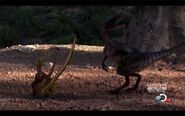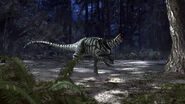No edit summary |
(→Errors) |
||
| Line 30: | Line 30: | ||
==Errors== |
==Errors== |
||
*Orntiholestes lacked feathers, while in reality, it did had feathers like most other small theropod dinosaurs. |
*Orntiholestes lacked feathers, while in reality, it did had feathers like most other small theropod dinosaurs. |
||
| + | |||
| + | *Ornitholestes teeth were actually covered by lips in life as recent studies confirmed. |
||
*Ornitholestes was found in the USA and not eurpope as the show sugested but teeth assigned to Richardoestesia have been found in the area the show takes place in. |
*Ornitholestes was found in the USA and not eurpope as the show sugested but teeth assigned to Richardoestesia have been found in the area the show takes place in. |
||
Revision as of 00:01, 16 March 2018

| |
| Creature information | |
| Scientific name : | Ornitholestes hermanni |
| Time period : | Late Jurassic 160-130 |
| Primary diet : | Carnivore |
| In the series | |
| Appearances : | The Watering Hole |
Ornitholestes was an ornitholestine coelurosaur of the Jurassic period. It was a relatively small predator who probably hunted small lizards and early mammals. It was once believed to have a crest on its nose. It is sometimes known as the coytote or the velociraptor of the Jurassic period
Physical Characteristics
Ornitholestes was a bipedal carnivore. Its head was proportionally smaller than that of most other predatory dinosaurs, but the skull was heavily built, with a short snout and robust lower jaw. The orbits (eye sockets) were quite large, measuring over 25 percent of the skull's length. There is no indication of a bony eye ring.
The front teeth of Ornitholestes were somewhat conical, with reduced serrations; the back teeth were recurved and more sharply serrated, similar to those of other theropod dinosaurs. Henry Fairfield Osborn (1903) counted four teeth in the premaxilla, of which the front tooth was the largest in the upper jaw. In contrast, Gregory S. Paul (1988) depicted the skull with only three premaxillary teeth remaining, much smaller than those illustrated by Osborn. Each maxilla (main tooth-bearing bone in the upper jaw) contained ten teeth, and each dentary (tooth-bearing bone in the lower jaw) contained twelve teeth. The tooth rows of Ornitholestes were short, with the dentary (lower) row being even shorter than the maxillary (upper) row, even though the dentary bone itself was exceptionally long at the back, reaching a point below the middle of the eye socket. Teeth did not extend as far back as the orbits, and neither tooth row spanned much more than one-third of the skull.
An area of broken bone near the external naris (nostril) appears to bulge upward, which led Gregory S. Paul to suggest in Predatory Dinosaurs of the World (1988) that Ornitholestes had a nasal horn "rather like a chicken's comb in looks." Both Oliver W.M. Rauhut (2003) and Kenneth Carpenter et al. (2005a) rejected that interpretation, and indicated that the upward flare of bone was due to post-mortem crushing of the skull. Paul's updated illustration of Ornitholestes in his 2010 Princeton Field Guide to Dinosaursno longer contains the nasal horn.
Discovery and Naming
Ornitholestes was the first theropod to be discovered in the 1900s. The holotype skeleton (AMNH 619) was excavated in July 1900 in the Bone Cabin Quarry in Wyoming by an American Museum of Natural History expedition by Peter C. Kaisen, Paul Miller and Frederic Brewster Loomis. It represents a partial skeleton with skull, including numerous elements of the vertebral column, the forelimbs, pelvis and hindlimbs. Henry Fairfield Osborn named and scientifically described the specimen in 1903. The genus name Ornitholestes, initially suggested by Theodore Gill, means "bird robber" and is derived from the Greek ὄρνις/ornis, ornithos ("bird") and λῃστήσ/lestes("robber"). The species name (O. hermanni) honors Adam Hermann, the head preparator at the Museum, who directed the restoration and mounting of the skeleton.
An incomplete hand (AMNH 587) was assigned to Ornitholestes by Osborn in his 1903 description of the genus. However, as Gregory S. Paul (1988) noted, the poor preservation of the corresponding elements in the type specimen made this association "tentative." In 2005, Kenneth Carpenter et al. described a new small theropod, Tanycolagreus, whose skeleton was found in Bone Cabin Quarry only a few hundred yards from AMNH 587. Since AMNH 587 was virtually identical to the preserved hand of the Tanycolagreus type specimen, it is now considered to belong to that dinosaur and not to Ornitholestes. Following this reassignment, Phil Senter (2006) noted that "our knowledge of Ornitholestes can be drawn now only from the holotype." John Foster (2007) reported that some fragments from Dry Mesa Quarry may belong to Ornitholestes, though these have not yet been described.
In 1920 Charles Whitney Gilmore concluded that Ornitholestes was identical to Coelurus; in 1934 Oliver Perry Hay recognised only a difference at the species level, naming aCoelurus hermanni, but in 1980 John Ostrom revived the genus.
In Dinosaur Revolution
A noisy Ornitholestes (probably another type of coelurosaur) is first decapicated by a female Allosaurus after disturbing her and her youngsters in the very early morning. Another member of the same species played a comic relief role later in the episode, as it ran around chasing a Rhamphorhynchus, even climbing a tree at one point, and constantly failing to achieve it's goal. It was last seen still chasing the pterosaur as the watering hole dried up and the rains didn't arrive yet. And in reality probably wasn't that dumb
Trivia
The Ornitholestes may have been actually a Compsognathus, a Sciurumimus or Juravenator due to location.
Errors
- Orntiholestes lacked feathers, while in reality, it did had feathers like most other small theropod dinosaurs.
- Ornitholestes teeth were actually covered by lips in life as recent studies confirmed.
- Ornitholestes was found in the USA and not eurpope as the show sugested but teeth assigned to Richardoestesia have been found in the area the show takes place in.
- Ornitholestes couldn't be still alive for seconds without a head and would die instantly after losing a head like most of today's animals that lost heads, but this could have been only for comic mischief.



